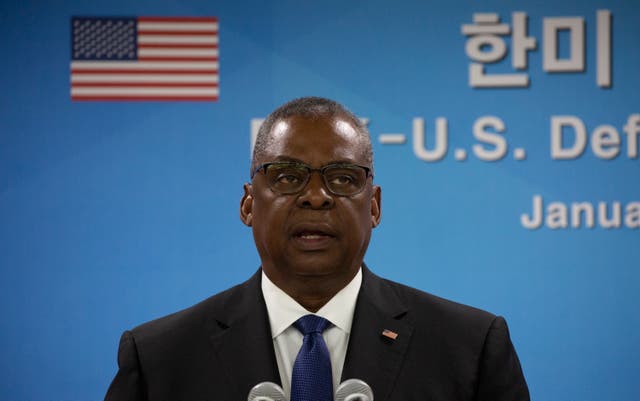
Nick Abbot 10pm - 2am
31 January 2023, 09:14

US Defence Secretary Lloyd Austin held talks with South Korean Defence Minister Lee Jong-sup in Seoul.
US Defence Secretary Lloyd Austin has said America will increase its deployment of advanced weapons such as fighter jets and bombers to the Korean Peninsula as it strengthens joint training and operational planning with South Korea in response to a growing North Korean nuclear threat.
Mr Austin made the comments in Seoul after he and South Korean Defence Minister Lee Jong-sup agreed to further expand their combined military exercises, including a resumption of live-fire demonstrations, and continue a “timely and co-ordinated” deployment of US strategic assets to the region, according to their offices.
The two men also discussed preparations for a simulated exercise between the allies in February, aimed at sharpening their response if North Korea uses nuclear weapons.

Mr Austin’s trip comes as South Korea seeks stronger assurances that the United States will swiftly and decisively use its nuclear capabilities to protect its ally in face of a North Korean nuclear attack.
South Korea’s security jitters have risen since North Korea test-fired dozens of missiles in 2022, including potentially nuclear-capable ones designed to strike targets in South Korea and the US mainland.
South Korea and the US have also been strengthening their security co-operation with Japan, which has included trilateral missile defence and anti-submarine warfare exercises in past months amid the provocative run in North Korean weapons tests.
In a joint news conference following their meeting, Mr Austin and Mr Lee said they agreed that their countries’ resumption of large-scale military drills last year, including an aerial exercise involving US strategic bombers in November, effectively demonstrated their combined capability to deter North Korean aggression.
The allies had downsized their training in recent years to create room for diplomacy with North Korea during the Trump administration and because of the Covid-19 pandemic.

Mr Austin said: “We deployed fifth-generation aircraft, F-22s and F-35s, we deployed a carrier strike group to visit the peninsula, you can look for more of that kind of activity going forward.”
He said the US’s commitment to protecting its allies with its full range of military capabilities, including nuclear ones, remains “ironclad”.
North Korea’s ramped-up missile tests have been punctuated by threats to pre-emptively use its nuclear weapons in a broad range of scenarios in which it perceives its leadership to be under threat, including conventional clashes or non-war situations.
Tensions could further rise in coming months with North Korean leader Kim Jong Un doubling down on his nuclear ambitions.
During a political conference in December, he called for an “exponential increase” in nuclear warheads, mass production of battlefield tactical nuclear weapons targeting South Korea, and development of more powerful long-range missiles designed to reach the US mainland.
Experts say his nuclear push is aimed at forcing the United States to accept the idea of North Korea as a nuclear power and negotiating badly needed economic concessions from a position of strength.
. @SecDef : It shows our unwavering commitment to maintaining peace on the Korean Peninsula. Over the past year, our two countries have made great progress in deepening our cooperation. pic.twitter.com/jdDkmcH0S5
— Department of Defense 🇺🇸 (@DeptofDefense) January 31, 2023
Nuclear negotiations between the US and North Korea have been derailed since 2019 because of disagreements over a relaxation of US-led economic sanctions against the North in exchange for steps by North Korea to wind down its nuclear weapons and missiles programmes.
North Korea’s growing nuclear arsenal and provocations have raised the urgency for South Korea and Japan to strengthen their defence postures in line with their alliances with the United States.
In an interview with The Associated Press this month, South Korean President Yoon Suk Yeol said his government was discussing with the Biden administration joint military planning potentially involving US nuclear assets.
In December, Japan made a major break from its strictly self-defence-only post-Second World War principle, adopting a new national security strategy that includes the goals of acquiring pre-emptive strike capabilities and cruise missiles to counter growing threats from North Korea, China and Russia.